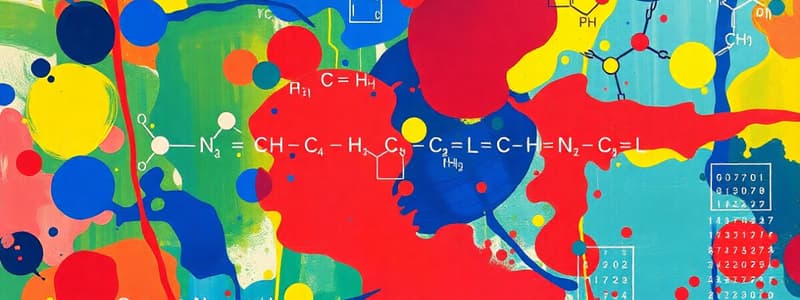Podcast
Questions and Answers
What is the coefficient for lithium hydroxide (LiOH) in the balanced chemical equation for the reaction between cobalt(II) acetate and lithium hydroxide?
What is the coefficient for lithium hydroxide (LiOH) in the balanced chemical equation for the reaction between cobalt(II) acetate and lithium hydroxide?
- 4
- 3
- 2 (correct)
- 1
The reaction between cobalt(II) acetate and lithium hydroxide is a single replacement reaction.
The reaction between cobalt(II) acetate and lithium hydroxide is a single replacement reaction.
False (B)
What is the molar mass of cobalt(II) acetate, Co(CH3COO)2?
What is the molar mass of cobalt(II) acetate, Co(CH3COO)2?
177.03 g/mol
The reaction between cobalt(II) acetate and lithium hydroxide produces ______ and lithium acetate.
The reaction between cobalt(II) acetate and lithium hydroxide produces ______ and lithium acetate.
Match the following terms with their definitions:
Match the following terms with their definitions:
Flashcards
Balanced Chemical Equation
Balanced Chemical Equation
Co(CH3COO)2(s) + 2LiOH(aq) → Co(OH)2(s) + 2LiCH3COO(aq) describes the substances and their quantities.
Reaction Type
Reaction Type
A chemical process where two compounds exchange ions or bonds, resulting in new compounds; here, it's Double Replacement.
Moles of Cobalt(II) Acetate
Moles of Cobalt(II) Acetate
Calculated by dividing mass by molar mass: 1.580 g / 177.03 g/mol = 0.008925 mol.
Decomposition Reaction
Decomposition Reaction
Signup and view all the flashcards
Electron Transfer in Reactions
Electron Transfer in Reactions
Signup and view all the flashcards
Study Notes
Cobalt (II) Acetate Reaction
- Cobalt (II) acetate is added to a beaker, dissolved in water, and reacted with lithium hydroxide
- The balanced chemical equation is: Co(CH3COO)2(s) + 2LiOH(aq) → Co(OH)2(s) + 2LiCH3COO(aq)
- The reaction type is double replacement
Moles of Cobalt (II) Acetate
- The mass of cobalt (II) acetate is 1.580g
- The molar mass of cobalt (II) acetate is 177.03 g/mol
- The number of moles of cobalt (II) acetate is 0.008925
- The number of moles of cobalt (II) acetate is 8.925 x 10⁻³ mol
Reaction Types
- The reaction 2 Ba3P2 → 2 Ba3O + P4O10 is a decomposition reaction
Studying That Suits You
Use AI to generate personalized quizzes and flashcards to suit your learning preferences.




